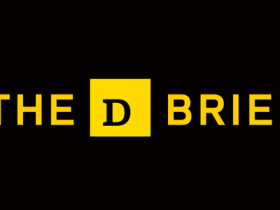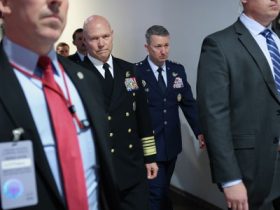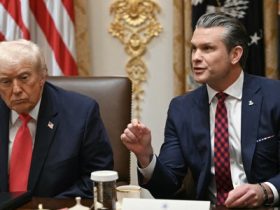ROME — British, Italian and Japanese firms set to build sensors and communications systems for the GCAP fighter have formed a UK-based consortium ready to sign a design and development contract with the platform’s lead integrators.
Known as GCAP Electronics Evolution (G2E), the consortium groups Leonardo and ELT Group from Italy, Leonardo UK and Mitsubishi Electric representing Japan, the firms said at the DSEI show in London.
Led by Leonardo UK manager Andrew Howard, G2E will be based in Reading near London, close to the office of GIGO, the Italy-UK-Japan government office running GCAP, and Edgewing, the tri-nation industrial joint venture set up by integrators BAE Systems (UK), Leonardo (Italy) and Japan Aircraft Industrial Enhancement Co. Ltd. (Japan).
“We can’t be an arms length supplier, we need to be deeply embedded on the program and this is the next piece of the jigsaw on GCAP after GIGO and Edgewing,” said Howard, who is currently Director Future Combat Air UK, Leonardo UK FCAS.
The consortium marks the next step in the team-up between the firms after they signed a collaboration deal at DSEI Japan in 2023.
“It’s the next chapter. We have been proving our technology on the UK Tempest fighter program since 2018, then working with our international partners and now the requirement has given us enough to set up work sharing and play to our strengths,” said Howard.
“The governments are satisfied their national champions have the skill sets,” he added.
In a statement released on Sept. 9, the firms said, “The four companies will work together to deliver the next-generation combat aircraft’s advanced sensing and communication system, known as Integrated Sensing and Non-Kinetic Effects & Integrated Communications Systems (ISANKE & ICS), as well as the system’s decades-long Through-Life Support Service (TLSS).”
It added, “The integration and exploitation of the vast amount of information that will be available in the future operational environment will be one of the key differences that will set the GCAP core platform apart from previous generations of combat aircraft.”
Howard pointed out how the size, weight and power of the fighter would be affected by the sensors on board, not to mention the outer mold line.
“Next-generation philosophy is about deeper interdependency between sensors, power and design. We need deeper integration on all levels,” he said.
Tighter cooperation between integrators and sensor firms would also speed up the work, he said.
“The need to deliver capability is clear, the Japanese have been very clear about this, and it feels like we can press the accelerator now.
The ‘Getting to know you phase’ is over and the ‘Get on an do it’ phase is starting,” he added.
Howard did not say when G2E would receive its first contract from Edgewing, but claimed the new consortium would now be able to get its job done in the “ten-year window” it has to produce the GCAP fighter by the 2035 delivery deadline.
After delivery, he said, “We want software upgrades to flow through the structure until it retires.”
Working with Japan now means “the time zone creates a longer day,” he said.
Given their national strengths, it is likely the U.K. and Japanese firms will take the lead on radar work, Italy will lead on Infrared Search and Track systems and Japan will lead on satellite communications.
The lead representatives from each company in the consortium are Howard from Leonardo in the U.K., Pietro Vanotti from Leonardo in Italy, Alberto De Arcangelis from Elt Group and Tatsuya Hirao, from Mitsubishi Electronics.
Tom Kington is the Italy correspondent for Defense News.
Read the full article here








Leave a Reply